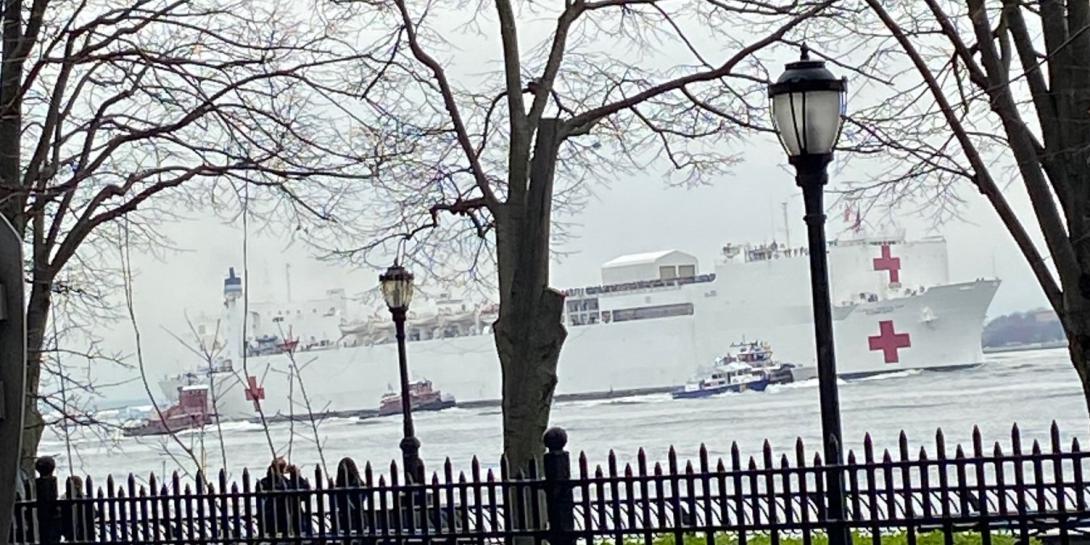Navy Boosts Hospital Ships’ Communications for COVID-19
U.S. Navy engineers, some working around the clock, updated the communications and networking capabilities of the two hospital ships dispatched to U.S. ports in the fight against the COVID-19 coronavirus. The USNS Comfort and the USNS Mercy originally deployed to New York City and Los Angeles, respectively, to provide hospital services to non-coronavirus patients in an effort to relieve local hospitals burdened with COVID-19 patients. Engineers with the Naval Information Warfare Systems Command (NAVWAR) tapped expertise from throughout the command as well as from counterparts with the Defense Information Systems Agency (DISA) to improve satellite communications and increase bandwidth.
Michael Winslow, division head for the Tactical Networks Division at Naval Information Warfare Center (NIWC) Pacific, explains that engineers carried out three major upgrades to the ships’ information systems. These were for the pier system, which entails the shore infrastructure that is used to connect each ship into a docking site. This system also backhauls information to sites where services are terminated. The second system worked on was for commercial broadband satellite program (CBSP). This effort increased the throughput for one ship while it transited to its destination. The third system was the automated digital networking system (ADNS).
Winslow notes that there was no conformation of requirements beyond the ships’ standard capabilities, but experts believed that a surge of new patients would lead to greater data flow in two key systems—the Theater Medical Information Program-Maritime (TMIP-M) and the Defense Medical Logistics Standard Support (DMLSS). TMIP-M helps personnel access electronic health records, track blood inventory, order supplies and track patient movements. DMLSS is used to acquire medical and surgical items, cleaning supplies and construction materials and equipment. An influx of new patients who had never been on the hospital ship necessitated these upgrades, Winslow offers. “We didn’t want the network and information technology systems to be the limitation. We wanted the ship to be able to freely support the supercritical mission it was providing.”
With the pier system, NIWC personnel worked with DISA experts and personnel from Verizon to provide pierside connectivity. The pierside infrastructure provided a degree of challenge, and this consumed 18 hours worth of work when the ship arrived on Monday. Winslow describes this effort as a rapid execution mechanism to bring Verizon into the connectivity and then link everything with DISA. He notes that connecting with DISA can take many days or even weeks, but the New York City connection was achieved in a matter of hours.
For the CBSP team, the mission was slightly different. Scott Boedeker, CBSP assistant program manager, explains that the CBSP systems needed no upgrading. There were, however, technological glitches on the Comfort that were uncovered before the ship set sail, and engineers raced to fix them before deployment.
Roy Golden, engineer for NIWC Atlantic, CBSP program, relates that both hospital ships had just undergone a major crew changeout while in a stand-down capability. When the requirement for the Comfort was issued, the new crew discovered that a terminal was not working at full capacity. The ships’ CBSP capability can be monitored from ashore, where increased pre-deployment scrutiny allowed experts to determine that the satellite data flow was not operating optimally just before it was to set sail.
Golden and Terell Turner, another engineer for NIWC Atlantic, CBSP program, went to the ship on Friday, March 27, and repaired a bad fiber connection that was inhibiting the ship’s ability to use its secondary CBSP system. Both engineers fixed the problem the day before the Comfort departed for New York City.
Additional personnel at NIWC worked with NETWARCOM and the satellite services vendor, INMARSAT Government, to establish good linkage with the secondary system. This added 4 megabits per second to the ship’s commercial satellite bandwidth, Boedeker says.
Arnel Castillo, CBSP lead for NIWC Atlantic, emphasizes that the work performed by Turner and Golden was largely proactive. They reached out to the ship when they realized the linkage shortcomings even before the ship’s crew could contact them. This ensured that the Comfort could be brought up to standards before it set sail.
The ship had an older ADNS baseline, so the NIWC enabled the rapid modernization of that baseline, Winslow relates. The center was contracted on Friday, March 27, to upgrade the back bandwidth aboard the Comfort to suit its new mission. One key step was to migrate the ship off of its satellite communications systems and onto the shore pier infrastructure. Another activity was to stage new hardware to increase network performance, and this was achieved with NIWC Atlantic literally taking hardware out of labs and onto the ship. This was done on Friday night, he observes.
The Fleet Readiness Directorate out of headquarters helped place a fleet support engineering team represented aboard the ship before it left, Winslow says. But none of the NIWC employees were needed on the ship after it left port.
Winslow points out that these tasks were arranged and implemented while everyone was working in a distributed telework environment. A handful of engineers did work in the laboratory over the weekend, he notes.
The information traffic from the ships to the Navy data center, from which other facilities—such as a research organization—can pull information as needed, Winslow notes.





Comments